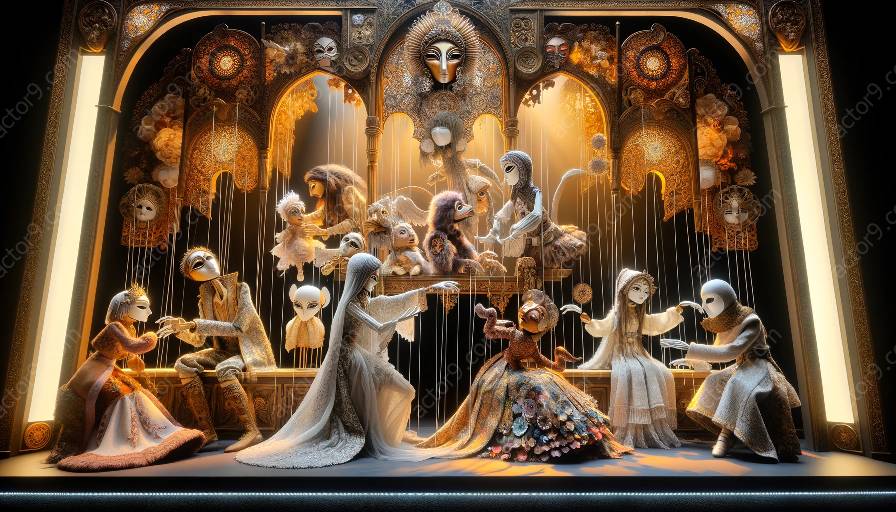When it comes to puppetry and mask work in theatre, the use of different materials can significantly influence improvisation possibilities. Understanding how these materials impact the creative process is essential for performers and artists to explore the full potential of their craft. In this article, we will delve into the influence of various puppetry and mask materials on improvisation, and how this relates to the broader context of improvisation in theatre.
Understanding Puppetry and Mask Materials
Before delving into the influence of materials on improvisation, it's important to understand the different types of materials commonly used in puppetry and mask work. These materials can range from traditional to modern, and each has its own unique characteristics that can shape the performance and improvisation possibilities.
Traditional Materials
Historically, puppetry and mask materials were often derived from natural sources such as wood, leather, and fabric. These materials provided a sense of authenticity and cultural significance to the performances. For example, the use of carved wooden puppets in traditional puppetry allowed for limited movement but imbued a sense of tradition and history. Similarly, masks crafted from natural materials like leather could evoke specific cultural or ceremonial contexts, influencing the improvisation of performers within those contexts.
Modern Materials
With technological advancements and the evolution of theatrical techniques, the use of modern materials such as plastics, fiberglass, and synthetic fabrics has become prevalent in contemporary puppetry and mask work. These materials offer greater flexibility, durability, and visual appeal, opening up new avenues for improvisation. For instance, a puppet made from lightweight materials can be manipulated with greater ease and precision, leading to more dynamic improvisational movements. Likewise, masks constructed from innovative materials can enable performers to express a wider range of emotions and physicality during improvisation.
Influence on Improvisation Possibilities
Now that we have explored the range of materials used in puppetry and mask work, it's crucial to consider how these materials influence improvisation possibilities. The influence can be observed in various aspects of performance, including movement, expression, and interaction.
Movement and Manipulation
The physical properties of puppetry and mask materials directly impact the movement and manipulation possibilities for performers. For example, a puppet made from natural materials like wood may have a limited range of movement, requiring performers to adapt their improvisation to work within those constraints. On the other hand, modern materials offer enhanced articulation and mobility, allowing for more fluid and expressive improvisational movements. Understanding the movement capabilities of different materials empowers performers to make creative choices that align with the intended improvisational narrative.
Expression and Emotion
Materials also play a significant role in expressing emotions and conveying character traits during improvisation. Traditional materials may carry cultural or symbolic significance that informs the emotional portrayal of characters. For instance, a leather mask with intricate designs may evoke a sense of mystique and tradition, influencing improvisational choices related to character demeanor and expression. Conversely, modern materials can provide a blank canvas for performers to project a wider range of emotions, leveraging the flexibility and malleability of the materials to enhance improvisational storytelling.
Interaction with the Environment
Consideration of materials extends to the interaction between performers and the performance environment. The weight, texture, and sound properties of different materials influence how performers engage with the space around them. A heavy, cumbersome puppet may necessitate deliberate and calculated movements, impacting the improvisational exploration of the performance space. Conversely, lightweight and agile materials afford performers the freedom to interact more dynamically with the environment, shaping the improvisation in response to the surrounding elements.
Implications for Improvisation in Theatre
The influence of puppetry and mask materials on improvisation holds broader implications for the theatrical landscape. Understanding these implications can enrich the collaborative process between performers, directors, and designers, ultimately enhancing the audience's theatrical experience.
Creative Collaboration
Exploring the potential of different materials fosters a spirit of creative collaboration among artists. Performers, puppeteers, and designers can engage in a dialogue about the capabilities and limitations of materials, informing the improvisational choices within a production. This collaborative approach encourages an exchange of ideas and techniques, leading to innovative and compelling performances that transcend traditional boundaries.
Audience Engagement
The use of varied materials can also heighten audience engagement and immersion. The visual and tactile qualities of different materials captivate and intrigue audiences, drawing them into the world of the performance. When audiences witness the seamless improvisation facilitated by carefully chosen materials, they are more likely to be emotionally invested in the narrative, creating a lasting impact that extends beyond the confines of the stage.
Conclusion
The use of different puppetry and mask materials significantly influences improvisation possibilities in theatre. By understanding the unique characteristics and implications of these materials, performers and artists can harness their creative potential to bring compelling narratives to life. As the boundaries of puppetry, mask work, and theatre continue to expand, the thoughtful exploration of materials as a catalyst for improvisation promises to inspire new forms of storytelling and artistic expression.




























